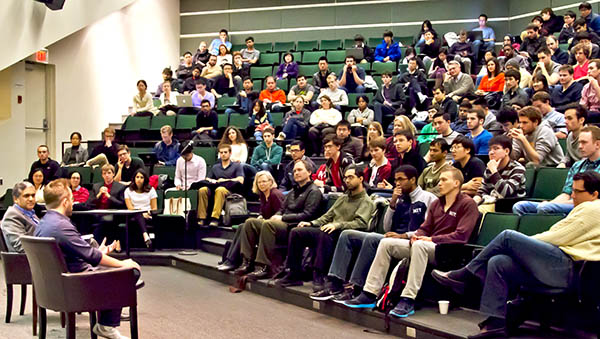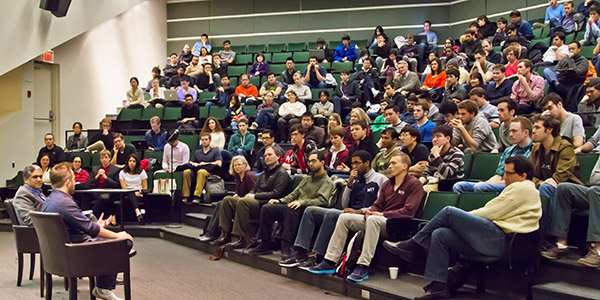
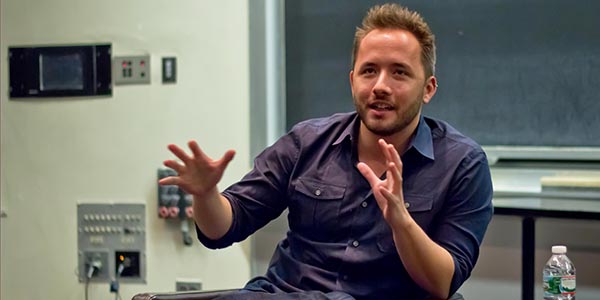
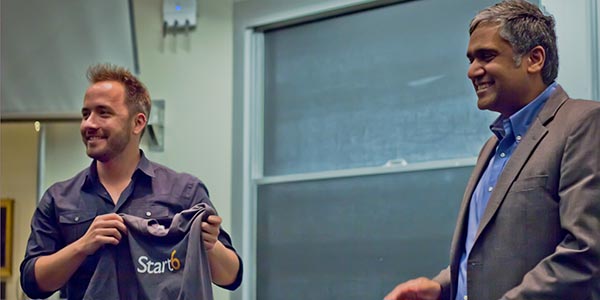
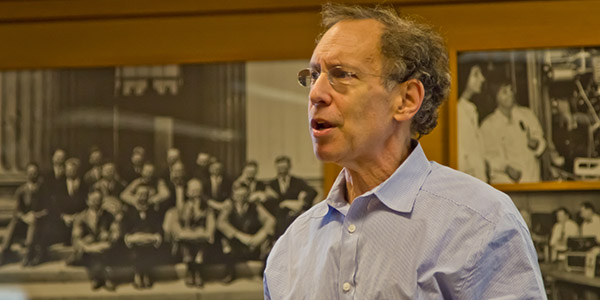
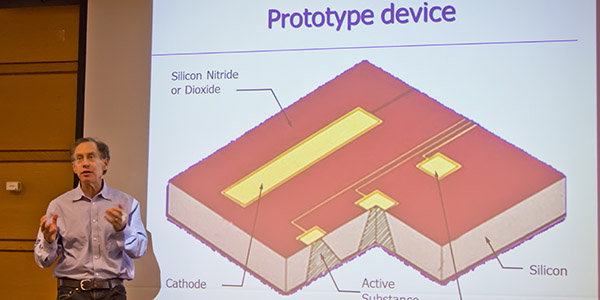
Written by Patricia Sampson
Photos by Rahul Rithe
Start6, the new EECS IAP workshop for immersion in innovation and entrepreneurship, wrapped up its third week with sendoffs from two icons in the world of startups: Drew Houston, ’05, Co-founder and CEO of Dropbox, and Institute Professor Bob Langer.
Houston joined Anantha Chandrakasan, EECS Department Head and creator of Start6, for a fireside chat on Monday, January 27. A full crowd of interested students from across campus came to hear Houston describe his experiences and offer advice on taking the plunge to launch a startup.
More software-run startups mean more CS-educated and technically savvy CEOs
Pointing out how enrollment in EECS and particularly in Computer Science is up almost 30%, Chandrakasan queried Houston about the place of CS in the overall MIT curriculum. “Should computing be a general Institute requirement, like Chemistry or Physics, for example?” Chandrakasan asked.
Houston not only agreed that CS should be an Institute requirement, but made the case for this change. He pointed out that over the last 15 years, the Internet has completely changed how people find information and how they act and use commerce – giving as an example the widespread use of credit cards online. “Now all kinds of major industries including education and agriculture are being turned upside-down by software, which is rocking all industry,” Houston told the large crowd gathered in 34-101. “So absolutely, people are massively underestimating the shift. It’s now not only possible but it’s ordinary that a couple of kids in a dorm room can build something that reaches millions of people, completely changing the way [people] do something.”
As a student at MIT, Houston told the crowd, he not only loved 6.046, Intro to Algorithms, but he also discovered, while taking several management classes, that methodologies in the business world – including negotiation – were not magic, but followed an understandable framework. He suggested that picking up the business side on the fly was not out of reach for any MIT engineering student. “VCs are a lot happier if you’re wearing a brass rat from Course 6,” he noted, “than an MBA from Harvard.”
Chandrakasan asked Houston about the November 2013 Forbes article on Stanford versus MIT startups – a piece that suggested marketing-based startups out of Stanford trump technology-driven startups out of MIT.
Houston repeated that as more and more industries are software-driven, technology will be more and more important. “Although Stanford students are surrounded with startups everywhere in the Bay area,” Houston said, “think about Zuckerberg and Gates… engineers first and then picked up the business side. It’s not some other class of people that can only figure this [marketing and management] out,” Houston challenged the Start6 students.
Preparing MIT to lead the new wave of entrepreneurs
Houston also suggested that as MIT seeks to foster entrepreneurship, more students should be encouraged to take up to 6-month internships with top-tier, venture-backed startups. He was personally involved in five other startups before Dropbox.
Houston was also involved as an MIT undergraduate in leadership kinds of roles such as running fraternity rush and becoming active in an entrepreneurship club. He also credits training himself on management principles by poring over management textbooks he bought online.
“What got you up to speed to take on founding Dropbox?” one student asked.
Houston responded that the process took lots of “baby steps” from his first startup internship as a senior in high school to deciding to build Dropbox with Course 6 classmate and then junior, Arash Ferdowsi, to managing a company of over 500 employees. At the time he conceived of Dropbox — after forgetting his memory stick as he left Boston for NYC in late 2006, after he had graduated — Drew realized the beauty of MIT’s Athena workstations. A workstation was always available – when he was a student. His and Arash’s goal as they developed the code that became Dropbox was (and is) to become the Athena station for the world. “It felt delusional … to have this goal,” Drew said. “But that was when there were just two of us.”
Product- versus software-based startups: Bob Langer’s formula
While Drew Houston represents an entrepreneurial idol as a recent Course 6 graduate, as the speaker at the MIT Commencement (2013) and as a frequent mentor for EECS students engaged in innovation, Robert S. Langer, the David H. Koch Institute Professor, the most cited engineer in history, and founder of 26 companies, gave the final Start6 sendoff on January 28. He shared his formula with a receptive group.
Langer recommended starting with platform-building technologies for long-term successful manufacturing of products that are covered by a broad blocking patent, and established by publication in a top journal. He encouraged what he called the ‘champion effect.’ “You want people who will walk through walls to make things work to be at the company, ” he said. “You care a lot more for [their] passion than experience.” He cited Steve Job’s starting Apple, the company’s subsequent decline when Jobs was forced to leave, and its historic rise to the top on his return.
From the lab to creating companies – a less common concept in the 1970s
Langer told the stories of six companies that he founded with his students, starting in the late 1970s. He noted that in five of the six, the idea of starting a company followed the publication and broad patent of the original discovery. He said that although MIT was not actively encouraging startups in those days, his experiences were all successful. Not one of his companies has gone under.
As a postdoc in the 1970s under Dr. Judah Folkman at Boston Children’s Hospital, Bob Langer developed a way to deliver large molecules in unaltered state for slow-release therapeutic treatments. After 200 unsuccessful trials, he discovered a way to accomplish this and published the work in Nature. Although Children’s Hospital had never filed for a patent and the US Patent Office turned down his requests for five years, Langer was able to gather literature citations pointing to how surprising his results were, and the scientists who wrote them signed affadavits that this was true. The patent examiner was convinced by these statements, and a very broad patent was granted.
Several large companies licensed this patent but didn’t work very hard to develop them, Langer related. So with a group of former students, he started a company, which merged with the nascent company on the floor below. Today, Alkermes, a $7 billion company with 1200 employees, produces 25 products that treat schizophrenia, diabetes and other major human disorders.
After describing of five additional companies and answering a number of questions, Prof. Langer advised that the biggest reason for success or failure is the CEO. He also urged that younger inventors do due diligence to determine how to deal with venture capitalists and investors. “The pie is only so big. Dig deep in your heart about what you want to do.”
In answer to a question about Drew Houston’s lack of emphasis on patents, Bob Langer agreed with Houston’s advice, noting the importance of patents in the life sciences compared with the information and computer sciences where marketing takes a bigger role. From their own perspectives, Langer and Houston each encouraged the Start6 students. As Drew Houston put it, “Do it [launch a startup] now!”
Start6 concluded its final day (of twelve) with the last of the individual project presentations – all potential startups that will continue to benefit from further mentorship and development. Start6 students were also invited to sign up for a spring break trip to the Bay area to visit with several VCs and startups.
News Image:
